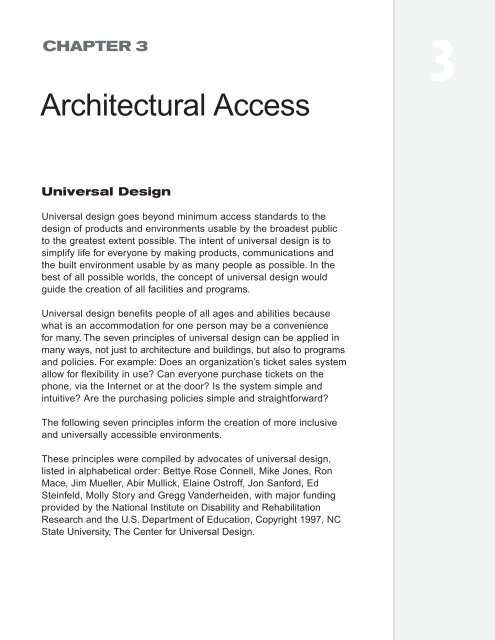Design for Accessibility: A Cultural Administrator's Handbook
Design for Accessibility: A Cultural Administrator's Handbook
Design for Accessibility: A Cultural Administrator's Handbook
Create successful ePaper yourself
Turn your PDF publications into a flip-book with our unique Google optimized e-Paper software.
CHAPTER 3<br />
Architectural Access<br />
3<br />
Universal <strong>Design</strong><br />
Universal design goes beyond minimum access standards to the<br />
design of products and environments usable by the broadest public<br />
to the greatest extent possible. The intent of universal design is to<br />
simplify life <strong>for</strong> everyone by making products, communications and<br />
the built environment usable by as many people as possible. In the<br />
best of all possible worlds, the concept of universal design would<br />
guide the creation of all facilities and programs.<br />
Universal design benefits people of all ages and abilities because<br />
what is an accommodation <strong>for</strong> one person may be a convenience<br />
<strong>for</strong> many. The seven principles of universal design can be applied in<br />
many ways, not just to architecture and buildings, but also to programs<br />
and policies. For example: Does an organization’s ticket sales system<br />
allow <strong>for</strong> flexibility in use? Can everyone purchase tickets on the<br />
phone, via the Internet or at the door? Is the system simple and<br />
intuitive? Are the purchasing policies simple and straight<strong>for</strong>ward?<br />
The following seven principles in<strong>for</strong>m the creation of more inclusive<br />
and universally accessible environments.<br />
These principles were compiled by advocates of universal design,<br />
listed in alphabetical order: Bettye Rose Connell, Mike Jones, Ron<br />
Mace, Jim Mueller, Abir Mullick, Elaine Ostroff, Jon San<strong>for</strong>d, Ed<br />
Steinfeld, Molly Story and Gregg Vanderheiden, with major funding<br />
provided by the National Institute on Disability and Rehabilitation<br />
Research and the U.S. Department of Education, Copyright 1997, NC<br />
State University, The Center <strong>for</strong> Universal <strong>Design</strong>.


